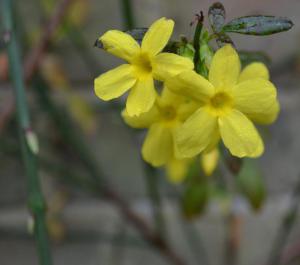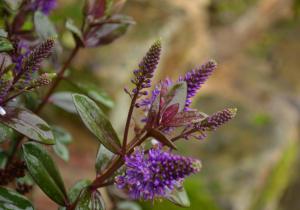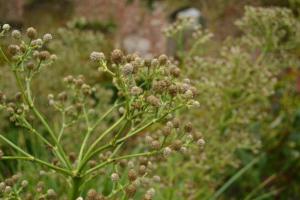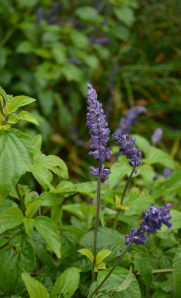Jasminum nudiflorum– Orchard / South Cottage wall
Common name: winter jasmine, native to China. This winter shrub has bright yellow flowers and long arching branches that can be trained up against a wall/fence on wires or trellis. It flowers from November to March and should be pruned hard after flowering has finished. Jasminum nudiflorum is very easily propagated by layering and will often do this itself when used as ground cover. At Sissinghurst we grow jasminum nudiflorum in the Orchard on the rear of South Cottage, on wires under the window. This is because when the cottage is used flowers can be seen from the house even in winter without having to go outside in the cold.
Hebe ‘Amy’- Top courtyard
This upright evergreen shrub has purple stems with lance shaped glossy purple/dark green leaves. The flowers are a rich purple in dense racemes. Hebe ‘Amy’ is a hybrid of the tender Hebe speciosa so some frost protection may be needed. Sometimes a second flush of flowers can be achieved if it is pruned directly after flowering which will prolong its flowering season.
Halesia monticola var. vestita – Cottage Garden
Common name: snowdrop tree. This deciduous tree is conical in shape with flowers on the underside of the branches in May. The flowers are white and resemble a snowdrop flower. The seed pods are unusually very large and winged. This is a slow growing tree which can grow up to 10m high, 6m wide.
Eryngium pandanifolium – Lower Courtyard
This sward-like forming evergreen has large, erect flower stems producing a vast amount of flowers. The leaves have a very spiky edge. The flowers produced should be a deep purple but in recent years at Sissinghurst it hasn’t produced many purple flowers, so we may replace it this year.
Solanum jasminoides album – White Garden
Common name: potato vine. This semi evergreen has white star-shaped flowers with a yellow centre, the leaves/stem look very delicate and are a dull green. This can be trained up over arches like at Sissinghurst or on a trellis/obelisk. It can also be grown in a conservatory in a large container and moved out during the summer and put back in during the winter.
Salvia indica ‘Indigo Spires’ – Rose Garden
Common name: indigo Spire sage. This is a vigorous hybrid with 12- to 15-inch long, twisting spikes of dark violet flowers. The parent plants are presumed to be S. longispicata and S. farinacea. It was discovered at Huntington Botanical Gardens and introduced into horticulture in 1979. It is a non-stop bloomer from early summer through until the first frost. Blooming can be further encouraged by pinching stem tips early in the growing season and deadheading the spikes once they fade. This can quickly grow to over 1m high, and can be grown as an annual where not hardy.
Jon Fenlon






